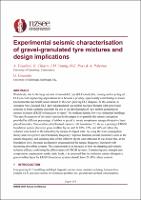Experimental seismic characterisation of gravel-granulated tyre mixtures and design implications

Download
Date
2021-04-14Authors
Tasalloti, Ali
Chiaro, Gabriele
Young, Julia
Ross, Olivia
Granello, Gabriele
Palermo, Alessandro
Metadata
Show full item recordAbstract
Worldwide, due to the large amount of end-of-life tyre (ELT) stockpiles, reusing and recycling of ELTs in civil engineering applications have become a priority, significantly contributing to lessen environmental and health issues related to the ever-growing ELT disposal. In this context, in Aotearoa New Zealand, ELT-derived granulated tyre rubber (GTR) has been blended with gravel and concrete to form synthetic materials for use in the development of “eco-rubber geotechnical seismic-isolation (ERGSI) foundation systems” for medium-density low-rise residential buildings. The specific purpose of the study reported in this paper is to quantify the seismic mitigation provided by different percentage of GTR to gravel to create an optimum energy-dissipative layer placed beneath a fibre-reinforced rubberised concrete raft foundation. To do so, a prototype ERGSI foundation system placed on gravel-GTR layers with 0, 10%, 25%, and 40% of GTR (by volume) were tested in the laboratory by means of impact tests. By using the wave propagation theory and cross power spectral density frequency response function, modal parameters such as the natural frequency and damping ratio of the different layers were obtained. It was found that, at the foundation level, the peak acceleration decreased and the natural frequency increased with increasing the rubber content. This corresponds to an increase in both the damping and seismic-isolation effects, confirming the effectiveness of ERGSI systems. Considering also strength and compression requirements under static loads, it is proposed that the optimum seismic dissipative gravel-GRT layer for ERGSI foundation systems should have 25-30% rubber content.
